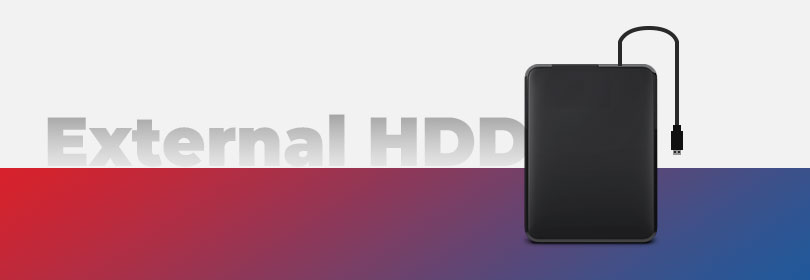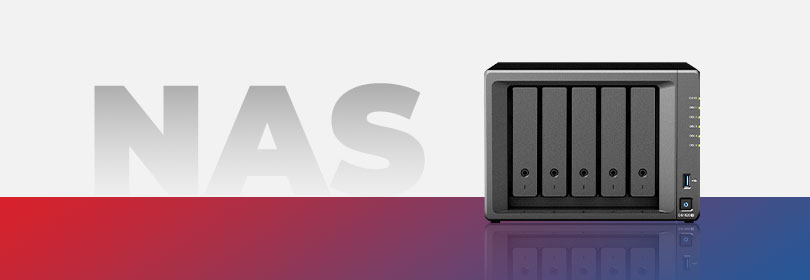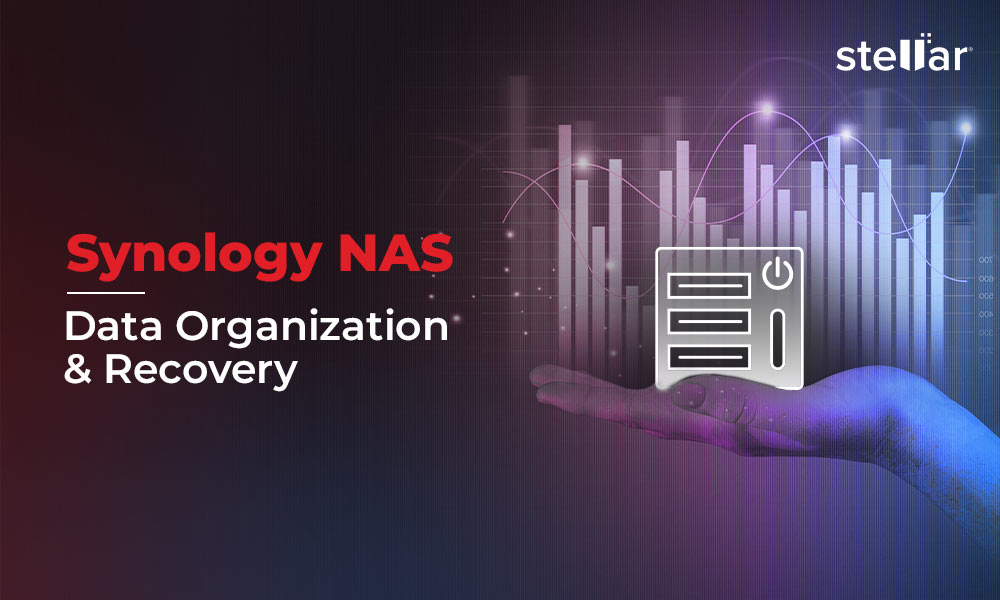What to Choose for Backup – External Hard Drive or NAS?
Summary: Choosing a NAS or external hard drive for Backup depends on several factors, such as technical expertise, ease of access, connectivity, storage capacity, and more. This guide shows a detailed comparison between NAS & an external hard drive to help you make a wise decision.
Data loss may occur due to drive errors, file corruption, or software or hardware issues. However, you can prevent it regularly backing up your system data. Several popular ways to back up data include cloud backup, server backup, external drives, etc.
External hard drives have been the primary method of storing backups for a long time as they are small, portable, and easy to use. You just have to connect an external hard drive to your computer and copy-paste or transfer your files, images, movies, etc.
However, we recently encountered several scenarios where users are adopting NAS for backup purposes. The technical advancements and the expanding need for data storage, availability, and accessibility have driven people to set up NAS devices.
So, which one is better- Good old external drives or NAS configuration to protect your data? Deciding on one could be easier if you know all the prerequisites. Here’s an overview of external hard drives and NAS devices covering the pros & cons. Additionally, we’ve included a comparison table showing NAS vs. HDD to help you make the best choice!
Difference Between External Hard Drive and NAS
An external hard drive is usually a removable drive you can attach to a computer, whereas NAS is a complete setup that can connect and access multiple computers. Let’s get more insights by discussing them separately.
External Hard Drives

External hard drives are typically removable hard drives that you can connect to your system through a USB cable or wireless. They are small, portable, and easy to carry, so you can move them around and take your data anywhere. These drives are used to store data when the system’s internal drive is at its total capacity. Additionally, you can use an external hard drive to back up essential files and other data and transfer or copy-paste them anytime. You can also use them as network drives to store shared data. The standard external hard drives include HDDs (Hard Disk Drives) and SSDs (Solid State Drives). WD (Western Digital), Samsung, Toshiba, Seagate, and SanDisk are some of the most popular external hard drive brands.
NAS (Network-Attached Storage)

Network-attached Storage (NAS) is a file-level storage device that stores and shares data for many connected computers. It provides excellent server uptime and keeps data available to users. NAS also supports data archiving and Backup. Users can easily collaborate and respond to other users’ requests or actions for storing and accessing data. It can include two or more hard drives for enhanced storage capacity.
Many of the latest NASs include RAID (Redundant Array of Independent Disks) to offer storage, redundancy, performance, or both. NAS has become more reliable when it comes to data security and provides higher storage with RAID inclusion. When discussing NAS, two brands come to mind: Synology and QNAP. However, other popular brands like Netgear, Seagate, Western Digital, and Buffalo are also available.
Network Attached Storage vs. External Hard Drive – Benefits and Drawbacks
Both devices offer various advantages and drawbacks. Here, we’ve listed both below.
External Hard Drive – Pros & Cons
Pros:
- External hard drives are portable and easy to use. They are available in different sizes and have various storage capacities.
- They can be connected to multiple devices with USB cables or FireWire.
- They are available with upgrades and different models, so there are no compatibility issues with various operating systems.
- They are mainly used for storage, backup, and file-sharing purposes.
Cons:
- External hard drives are portable and easy to use. They are available in different sizes and have various storage capacities.
- They can be connected to multiple devices with USB cables or FireWire.
- They are available with upgrades and different models, so there are no compatibility issues with various operating systems.
- They are mainly used for storage, backup, and file-sharing purposes.
Network-Attached Storage (NAS) – The Pros & Cons
Pros:
- NAS offers a single consolidated location to store and manage unstructured files and other data. Users can store, access, and share information across multiple devices.
- NAS can be scaled up with more hard drives to accommodate additional storage.
- NAS users can access NAS remotely with an internet connection, having convenient access to data on the go.
- NAS can be connected to different devices like systems, cameras, USB devices, and printers and pair them together for performance.
- Multiple NAS devices offer built-in backup and synchronization features to protect data in case of hardware or software issues.
- NAS devices are usually more affordable than traditional storage solutions, such as servers.
Cons:
NAS vs. HDD – What to Choose for Backup
To supplement the above information and help you find the best storage mechanism, we’ve compared various aspects of an External Hard Drive with NAS in this table below.
| Features | External Hard Drive | Network-Attached Storage |
| Configuration and Setup | The external hard drive is easier to connect with the system. To copy or transfer data, you can attach SATA or PATA cables to your device. | NAS requires technical expertise to be set up and configured. |
| Accessibility | You can easily access the drives and their data when you connect them to your system. No internet connection is required. | The NAS device requires a proper internet connection to work and allow users to store & share files. You can remotely access the NAS data if your NAS account is created. |
| Connection | It can be connected to one system at a time. You can additionally access drives’ data with a dual-monitor setup. | All the users connected to a network connection can access the NAS and store and share their data. |
| Backup Features | It can store multiple data types. However, this data still needs to be backed up for safety purposes. | NAS comes with backup and recovery features. It additionally offers surveillance, email communication, and support for third-party apps. |
| Storage Capacity | It offers a limited storage capacity compared to NAS, which can’t be expanded. When running at full strength, you would need to either delete unnecessary items to take off the load from the drive or buy a new one of a bigger size. | NAS offers greater storage capacity since it possesses two or more hard drives or RAID configured in the setup. |
| Fault Tolerance | There’s no fault tolerance in external hard drives. Once they’re damaged, they can lose data permanently. | With RAID 1, 5, 6, or 10 inclusion, NAS offers fault tolerance and can withstand up to one or more drives’ failure as per the RAID configuration. |
| Price | A single hard drive is less expensive | NAS HDDs are typically more expensive than regular drives. |
NAS or External Hard Drive?
Although external hard drives and NAS are viable options for creating data backups, the choice ultimately depends on your needs. Where external hard drives are simple to connect and use, NAS requires technical expertise to be configured and set up. However, in terms of data storage capacity and safety, NAS outperforms a regular external hard drive when RAID is included.
So, if you just want to back up your system data, external drives are a good choice. However, if you want to store and share your data in an enterprise and business setup, NAS is the ideal solution. In fact, some users also use NAS to leverage its benefits in their home setup.
But remember, be it an external drive or NAS, they both are prone to data loss scenarios. Hence, you must create backups of both these devices. Follow backups’ backup policy to prevent inevitable data loss. Additionally, a NAS data recovery software can be handy to restore data quickly.















Keeping it simple with external drives here. I shoot weddings and just need to back up photos safely. Got two drives I swap between. NAS seems like those fancy coffee machines with 50 buttons when all you want is a regular cup of joe. Plus I like knowing my stuff isn’t connected to the internet 24/7
This makes sense. External drives cost less upfront, but NAS seems like a better investment over time, especially for families or small businesses. Any tips on getting a good NAS without overspending?
I like the comparison. NAS works well for automating backups, especially with multiple devices. Is the setup process worth it for someone not tech-savvy?
Switched to a Synology NAS box 6 months ago and never looking back. Was tired of having photos scattered across 3 external drives. Yeah it cost more but totally worth it for the automatic backups alone.